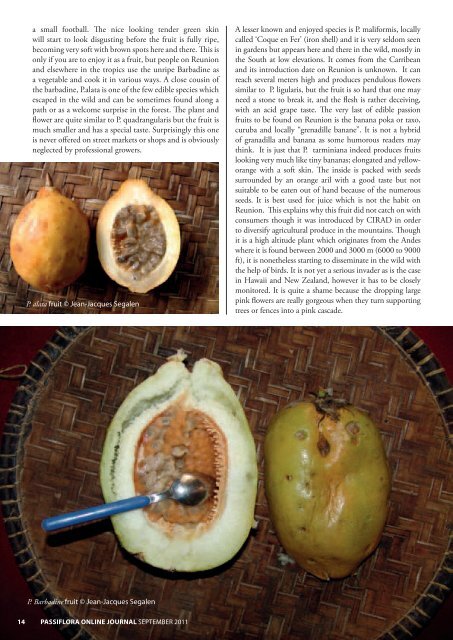Issue 2 2011 Lo-res PDF - Passion Flowers
Issue 2 2011 Lo-res PDF - Passion Flowers
Issue 2 2011 Lo-res PDF - Passion Flowers
Create successful ePaper yourself
Turn your PDF publications into a flip-book with our unique Google optimized e-Paper software.
a small football. The nice looking tender green skin<br />
will start to look disgusting before the fruit is fully ripe,<br />
becoming very soft with brown spots here and there. This is<br />
only if you are to enjoy it as a fruit, but people on Reunion<br />
and elsewhere in the tropics use the unripe Barbadine as<br />
a vegetable and cook it in various ways. A close cousin of<br />
the barbadine, P.alata is one of the few edible species which<br />
escaped in the wild and can be sometimes found along a<br />
path or as a welcome surprise in the fo<strong>res</strong>t. The plant and<br />
flower are quite similar to P. quadrangularis but the fruit is<br />
much smaller and has a special taste. Surprisingly this one<br />
is never offered on street markets or shops and is obviously<br />
neglected by professional growers.<br />
P. alata fruit © Jean-Jacques Segalen<br />
A lesser known and enjoyed species is P. maliformis, locally<br />
called ‘Coque en Fer’ (iron shell) and it is very seldom seen<br />
in gardens but appears here and there in the wild, mostly in<br />
the South at low elevations. It comes from the Carribean<br />
and its introduction date on Reunion is unknown. It can<br />
reach several meters high and produces pendulous flowers<br />
similar to P. ligularis, but the fruit is so hard that one may<br />
need a stone to break it, and the flesh is rather deceiving,<br />
with an acid grape taste. The very last of edible passion<br />
fruits to be found on Reunion is the banana poka or taxo,<br />
curuba and locally “grenadille banane”. It is not a hybrid<br />
of granadilla and banana as some humorous readers may<br />
think. It is just that P. tarminiana indeed produces fruits<br />
looking very much like tiny bananas; elongated and yelloworange<br />
with a soft skin. The inside is packed with seeds<br />
surrounded by an orange aril with a good taste but not<br />
suitable to be eaten out of hand because of the numerous<br />
seeds. It is best used for juice which is not the habit on<br />
Reunion. This explains why this fruit did not catch on with<br />
consumers though it was introduced by CIRAD in order<br />
to diversify agricultural produce in the mountains. Though<br />
it is a high altitude plant which originates from the Andes<br />
where it is found between 2000 and 3000 m (6000 to 9000<br />
ft), it is nonetheless starting to disseminate in the wild with<br />
the help of birds. It is not yet a serious invader as is the case<br />
in Hawaii and New Zealand, however it has to be closely<br />
monitored. It is quite a shame because the dropping large<br />
pink flowers are really gorgeous when they turn supporting<br />
trees or fences into a pink cascade.<br />
P. tarminiana fruit © Jean-Jacques Segalen<br />
P. Barbadine fruit © Jean-Jacques Segalen<br />
Now that stomachs are full let us feed your eyes. Although<br />
all the species mentioned so far, maybe with the exception<br />
of P.suberosa, have showy flowers themselves, a few species<br />
have been brought over solely for decorative purpose.<br />
Those are surprisingly very few when one considers<br />
the stupendously large choice of species and hybrids<br />
available nowadays. This is due to regulations raised<br />
by local nature protection bureaus who feared potential<br />
weeds and decided that as there were already several<br />
members of the family genus who proved to be invasive,<br />
the whole family should be forbidden to enter the island.<br />
This means that we can only get four of those jewels here<br />
which were imported before the ban. P.miniata whose<br />
bright red flowers are the ones you will more commonly<br />
find in gardens and which was erroneously sold for<br />
years as P.coccinea. Closely <strong>res</strong>embling this is P.vitifolia,<br />
which most people confuse with the first one but can be<br />
distinguished by its grape vine like three lobed leaves.<br />
P.caeruela has of course made its way here but as it does<br />
not take too well to the humidity and heat of lowlands it<br />
is not such a common sight. Lastly is P.’Amethyst’ which<br />
is also quite rare although it does fairly well.<br />
All in all, there is nothing exciting for those of you who<br />
ramble through the Amazon during your spare time or<br />
scan the Andes for new species, but I hope the amateurs<br />
and beginners will have enjoyed the reading! My next<br />
P. suberosa © Jean-Jacques Segalen<br />
article should cover a trip to French Guyana which will<br />
certainly be more entertaining.<br />
Jean-Jacques Segalen is a professional horticulturist<br />
specializing in seed production, living on tropical Reunion<br />
Island with a keen inte<strong>res</strong>t in vines and passion flowers.<br />
www.barbadine.com<br />
*Editor’s note. The P. suberosa species complex has been<br />
revised into a number of separate taxa by Kristen E.<br />
Porter-Utley. Revision of Passiflora Subgenus Decaloba<br />
Supersection Cieca (Passifloraceae)2003.<br />
14 Passiflora Online Journal September <strong>2011</strong><br />
Passiflora Online Journal September <strong>2011</strong><br />
15
















